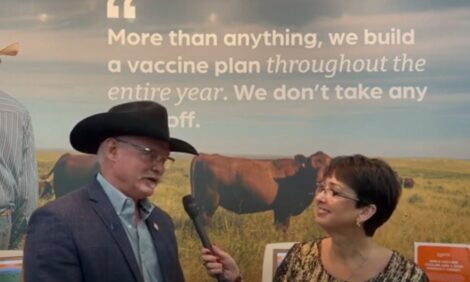



Feeding cattle for less methane
Methane is a loss of energy during feed digestion which reduces feed efficiencyCattle are ruminant animals and like all ruminants the fermentation process creates methane naturally. It is important to note that this is a naturally occurring process and not something that man is causing to occur. However, methane production has some negative effects in 2 manners. The one most talked about recently is the effect of methane on global warming. The second is that methane is a loss of energy during feed digestion; thus, reducing feed efficiency. Therefore, the reduction of methane emissions could improve beef sustainability by reducing the amount of greenhouse gases emitted and by increasing the amount of beef produced per pound of feed.
One of the most immediate methods to reduce methane emissions is through feed additives that change fermentation in the rumen or block methane production. These feed additives generally fall into 3 modes of action:
- fermentation modifiers
- electron sinks
- methane inhibitors
Fermentation modifiers change the bacterial pathways used to digest carbohydrates so that less methane can be produced. Electron sinks capture the hydrogen produced in the rumen from the digestion of carbohydrates. The hydrogen is used by rumen bacteria to produce methane and if there is less hydrogen then the bacteria cannot produce as much methane. Inhibitors affect the bacteria directly blocking the ability to produce methane. Table 1 shows several feed additives that can be used to reduce methane emissions, their category, and the average percent reduction in methane emissions.
Monensin is an ionophore that modifies fermentation to produce a different profile of end products from carbohydrate digestion. The change in end products means that there is less methane produced but is marginally effective (12%). The benefit of monensin is that the reduction in methane emissions is also accompanied by an increase in feed efficiency making this feed additive an economically viable means of methane reduction.
Unsaturated fat is in the categories of fermentation modifiers and electron sinks. The fat captures hydrogen to reduce methane emissions, but also changes the profile of end products from carbohydrate digestion similar to monensin. A benefit of using unsaturated fat as a feed additive is that it is a nutrient that does not require FDA approval for use in food animals and it is highly effective at reducing methane emissions (40%). A drawback of using unsaturated fat is the limited about that can fed to ruminants without negative effects on feed intake and feed digestion. Added unsaturated fat cannot exceed 3 to 4% of the diet without negative effects, and at these levels of dietary inclusion studies have reported decreased feed intake and milk yield in dairy cattle. Fewer studies have been published in feedlot cattle. Similar to monensin, the accompanied increase in feed efficiency may make this feed additive an economically viable means of methane reduction.
Nitrate is an electron sink that captures hydrogens as the bacteria convert the nitrate to ammonia, then use the ammonia for their own nitrogen requirement. Nitrate is moderately effective at reducing methane emissions (55%). A drawback to using nitrate is the high risk of toxicity. Cattle have to be adapted to the desired level of nitrate slowly to allow the rumen bacteria time to adjust. A benefit to using nitrate to reduce methane emissions is that it can replace other forms of nitrogen and protein in the diet thus not adding cost.
One of the new potential feed additives that is getting a lot of attention recently is 3NOP. 3NOP is a methane inhibitor blocking the production of methane and is highly effective (X%). However, 3NOP has a couple of drawbacks. Currently, 3NOP is not approved for use in the use although it is moving through the regulatory approval process. Additionally, being a methane inhibitor, 3NOP does not alter rumen fermentation end products and does not improve feed efficiency. Thus, there is no economic incentive of improved production efficiency to use 3NOP. Any economic incentive will need to come from outside the operation.
Feed additives can be used to reduce methane emissions; some with inherent economic incentives. Many other feed additives are being tested, but few if any as promising and as feasible as these listed here. However, all have limitations which will likely require outside economic incentives to increase adoption.



